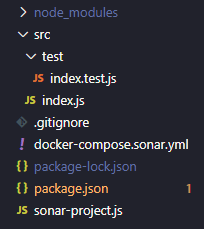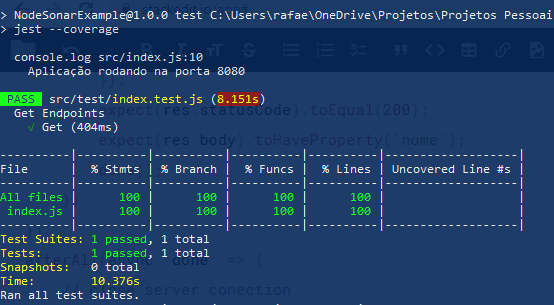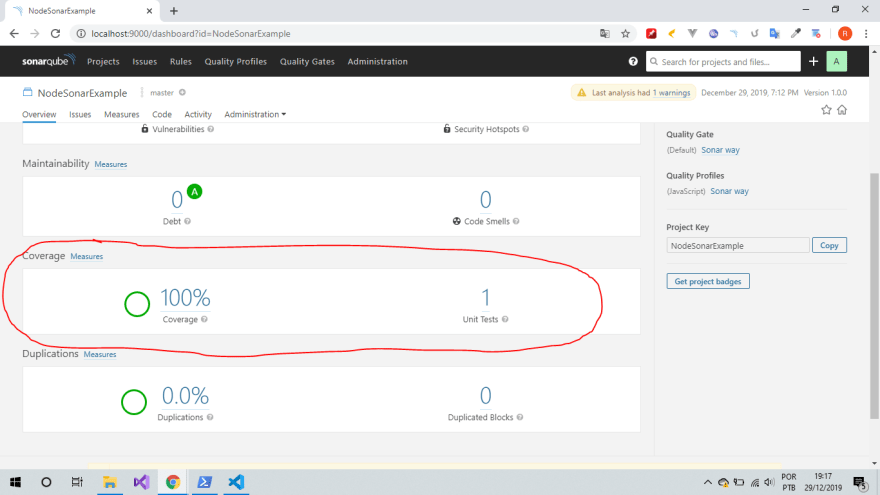NodeJs + Express + Docker + Jest + Sonarqube
In this article, we talk about a basic example using Nodejs, Express, Docker, Jest and Sonarqube.
Using the wikipedia explanation "SonarQube is an open source platform developed by SonarSource for continuous code quality inspection, to perform automatic reviews with static code analysis to detect bugs, code odors and security vulnerabilities in over 20 languages. programming."
For this tutorial, we'll need:
With node and docker installed, let's start the project
Starting the project
Creating project folder and browsing
mkdir NodeSonarExample
cd ./NodeSonarExample
Starting the project
npm init -y
Installing dependencies
In this session, we will install the dependencies and development dependencies for the project.
- Express which allows http requests, widely used in MVC and Restfull applications.
- Jest is used to perform unit testing.
npm install --save express jest
- sonarqube-scanner is necessary to scan JS code very simply, without needing to install any specific tool or (Java) runtime.
- jest-sonar-reporter is a custom results processor for Jest. The processor converts Jest's output into Sonar's generic test data format.
- supertest we can test http requests for express routes
npm install -D sonarqube-scanner jest-sonar-reporter supertest
Docker Image SonarQube
Let's start sonarqube by creating the docker-compose.sonar.yml file.
version: '3'
services:
sonarqube:
container_name: sonarqube
image: sonarqube:latest
ports:
- "9000:9000"
- "9092:9092"
and execute the file with the command:
docker-compose -f docker-compose.sonar.yml up -d
With sonarqube running, navigate to sonarqube address and authenticate using the default account
login: admin
password: admin
Authenticated, you will notice that there is no project pipeline created as shown in the image below
Simple project example
In this session, I will show the project structure, and all the code involved
Project structure
Code
file: src/index.js
const express = require('express');
const app = express();
const port = process.env.PORT || 8080
// Route to be tested
app.get('/', (req, res) => {
return res.status(200).json({ nome: 'Rafael Dias' });
});
// Application running on the door
let server = app.listen(port, () => {
console.log(`Application running on ${port}`);
});
module.exports = server;
file: sonar-project.js
const sonarqubeScanner = require('sonarqube-scanner');
sonarqubeScanner(
{
serverUrl: 'http://localhost:9000',
options : {
'sonar.sources': 'src',
'sonar.tests': 'src',
'sonar.inclusions' : '**', // Entry point of your code
'sonar.test.inclusions': 'src/**/*.spec.js,src/**/*.spec.jsx,src/**/*.test.js,src/**/*.test.jsx',
'sonar.javascript.lcov.reportPaths': 'coverage/lcov.info',
'sonar.testExecutionReportPaths': 'coverage/test-reporter.xml'
}
}, () => {});
module.exports = server;
Include these lines in your package.json file
file: package.json
{
.
.
.
"scripts": {
"sonar": "node sonar-project.js",
"test": "jest --coverage"
},
"jest": {
"testEnvironment": "node",
"coveragePathIgnorePatterns": [
"/node_modules/"
],
"testResultsProcessor": "jest-sonar-reporter"
},
"jestSonar": {
"reportPath": "coverage",
"reportFile": "test-reporter.xml",
"indent": 4
}
.
.
.
}
With the project created, just run
node src/index.js
With the project running, open the browser and navigate to http://localhost:8080/
the expected return is
{ name: 'Rafael Dias' }
Now let's go to automated testing to perform sonarqube test coverage
Automated test
let's create a test file. So we will import the index.js file and supertest to get the get request for route '/'.
In the end it is necessary to close the open server connection for the test to be terminated
file: src/test/index.test.js
const request = require('supertest')
const server = require('../index')
describe('Get Endpoints', () => {
it('Get', async (done) => {
const res = await request(server)
.get('/')
.send({
userId: 1,
title: 'test is cool',
});
expect(res.statusCode).toEqual(200);
expect(res.body).toHaveProperty('nome');
done();
})
})
afterAll(async done => {
// close server conection
server.close();
done();
});
To perform the tests, it is necessary to execute the command
npm run test
The test results should be successful as in the image below:
After all tests are successfully executed, a folder named "coverage" will be generated.
Coverage folder files are being referenced in sonar-project.js
finally, the command must be executed
npm run sonar
This command is responsible for executing the pipeline and committing SonarQube
As a result, you have 100% of your code covered per test, by default you need at least 80%







Top comments (1)
Very good tutorial! There is one error thou: you shall remove
module.exports = server;
from file: sonar-project.js.
Would you like to share how full flaged project in nodejs should be organized?